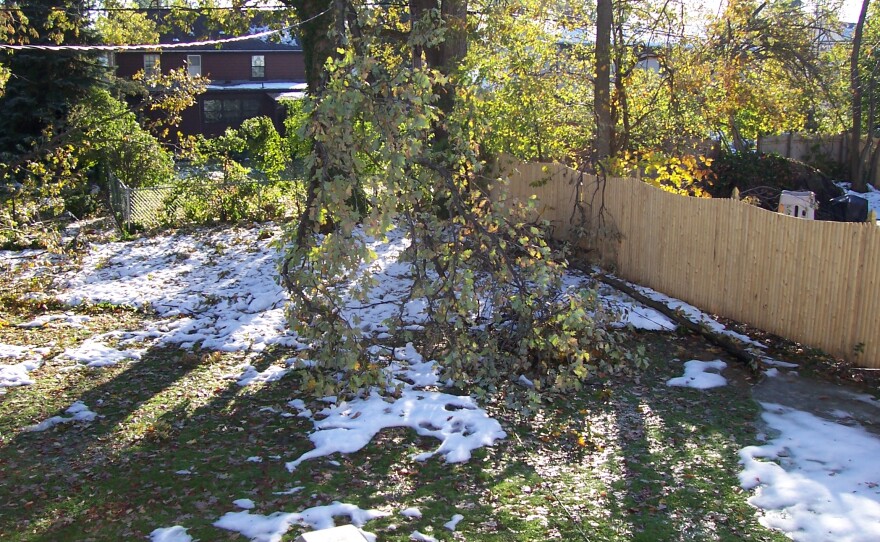Ten years ago, October 12, 2006, marks the arrival of the "October Surprise." It was an early Lake Effect snowstorm that hit Buffalo, crushing trees and bringing down power lines. It started the evening of October 12 and by Friday, October 13, there were extensive damage and heavy snow across the region. WBFO's senior reporter Eileen Buckley takes a look back and how our trees have recovered over the last decade.

“There’s a tree down that came down on a house”, stated an emergency crew member.

The sound of emergency crew on the evening of October 12, 2006 as I drove through the start of the storm in Eggertsville.
“All of these trees coming down, between, we’re at Main and Bailey,” said a responder.
The next morning in the City of Buffalo it was one of first major storm emergencies for Mayor Byron Brown's administration.
“Well I can tell you that we have various city crews out trying to remove down trees, plowing snow on main roads and secondaries…,” said Mayor Brown following the brunt of the storm.
And it was a similar situation across the community. Some roads were closed and power was knocked out to thousands of Western New Yorkers and 105-mile stretch of the State Thruway was also shut down.
It was an ice-style, lake-effect snow storm that paralyzed the area. Then Governor George Pataki arrived to assist with a full review, assessing the damage and declaring a State of Emergency for the Buffalo region.

“Where we stand right now is there is close to 380,000 customers in western New York without power. That hasn’t happened in New York State since the devastating ice storms that occurred about ten years ago,” Pataki remarked.
The October Surprise dumped up to two-feet of snow of Lake Effect snow. National Weather Service Meteorologist Chuck Tingley explained the situation for WBFO News.
“Well, historically, for this time of year, we just broke every record we had. It’s the most snow we’ve ever had this early…,” described Tingley.
October 12th actually started as somewhat mild fall day. Many trees still have leaves on them, but as the day progressed -- it turned rainy, windy and colder and by that evening, the heavy, wet snow started to fall and the extensive damage to trees began.
“Every tree across the city was affected in one way or the other,” said Andy Rabb, Deputy Commissioner of City Parks & Recreation.
Ten years ago Rabb left to work in New York City when the October storm hit Buffalo.
“I remember being in New York City and seeing the pictures on the news and then just called the Public Works Commissioner at the time to see if there was anything I could do to help, and then came back to Buffalo for a week to both make sure my family was okay and to see what we could do to help the unprecedented amount of damage to the trees across the city,”
Rabb recalled.

And since returning to Buffalo, Rabb has watched the long recovery of the city trees that survived, a healing process that has literally taken years.
“There were thousands of trees lost as a result of the October Surprise and to a certain degree, some trees we still see are succumbing to the ultimate decay issues, rot issues, from large branches that were lost to that storm that made it up to that point depending on species and other things. The trees that needed to be removed from that storm didn’t all just happen in the couple of years after the storm, although that’s when most of them came down. There were lingering effects from that storm that we worked through,” Rabb explained.
Now many have returned to full growth and have a strong shape. Rebuilding the tree stock has been the mission of Re-Tree of WNY. That organization has planted more than 28,000 trees with a goal of 30,000.

“You can’t just look at it as just a tree planting effort. It’s really engaging the community. In order for street trees to make it, most of them are in front of someone’s house, right? Or they’re out there. It’s a tough place for a tree to live, out on the street. So you need people to actually want them to happen,” stated Rabb.

Sitting at his City Hall desk, Rabb reflected ten years later on what has been replaced, what has healed and the future of our trees.
“Remember, trees are an investment in the future. You don’t see the results of the tree plantings until decades later, hopefully 50-years later,” Rabb responded
You can listen here to some of the coverage WBFO's news team provided the morning of Friday, October 13, 2006.







